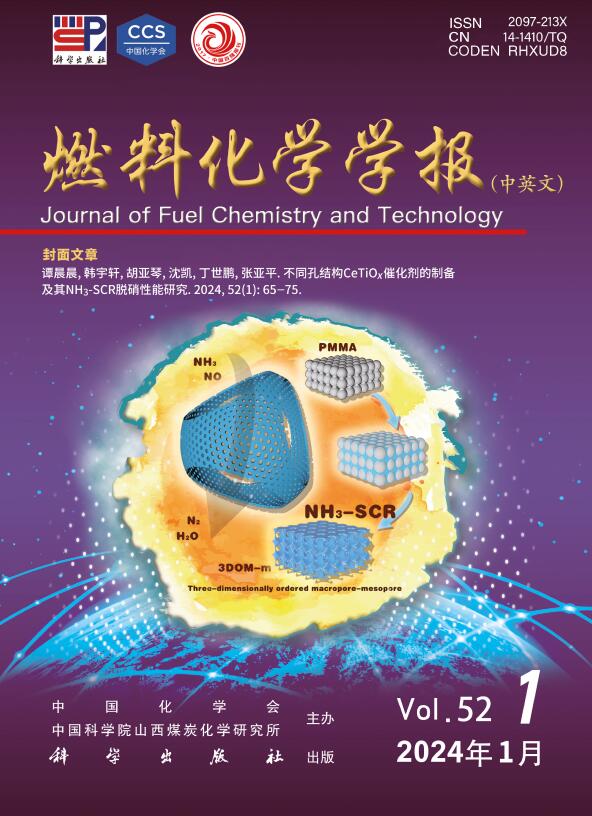Investigation into the pyrolysis mechanism of α-D-galactose to furfural and furan
Q3 Energy
引用次数: 0
Abstract
In this study, the density functional theory calculations were utilized to reveal the formation mechanisms and pathways of the significant products from α-D-galactose (the model compound of hemicellulose) pyrolysis. For the two main pyrolysis products, furan and furfural, 21 possible detailed reaction pathways were discussed for each product based on the concerted reaction mechanism. The results indicated that the energy barrier for the ring-opening reaction was the lowest at 190.07 kJ/mol in the initial reaction steps of α-D-galactose. The dominant pathway for the formation of furfural from α-D-galactose involves sequential ring-opening, isomerization, hemiacetal formation, two-step dehydration, and combined de-aldehyde and dehydration reactions, with an energy barrier of 291.53 kJ/mol. For furan, two highly competitive dominant pathways were identified, with energy barriers of 287.21 and 288.51 kJ/mol, respectively. In the former pathway, the small molecule volatiles formed are glycolic acid and water. While in the latter pathway, they are formic acid, formaldehyde, and water. In summary, this study could provide an in-depth understanding of the formation mechanisms of furan and furfural during the pyrolysis of α-D-galactose, which is helpful for better design, optimization, and control of biomass conversion.
α- d -半乳糖热解制糠醛和呋喃机理的研究
本研究利用密度泛函理论计算揭示了α- d -半乳糖(半纤维素的模式化合物)热解的重要产物的形成机理和途径。针对呋喃和糠醛这两种主要热解产物,根据协调一致的反应机理,讨论了每种产物21种可能的详细反应途径。结果表明,α- d -半乳糖开环反应的能垒最低,为190.07 kJ/mol。α- d -半乳糖生成糠醛的主要途径包括依次开环、异构化、半缩醛生成、两步脱水和脱醛脱水联合反应,能垒为291.53 kJ/mol。对于呋喃,确定了两条高度竞争的优势途径,其能垒分别为287.21和288.51 kJ/mol。在前一种途径中,形成的小分子挥发物是乙醇酸和水。在后一种途径中,它们是甲酸、甲醛和水。综上所述,本研究可以深入了解α- d -半乳糖热解过程中呋喃和糠醛的形成机理,有助于更好地设计、优化和控制生物质转化。
本文章由计算机程序翻译,如有差异,请以英文原文为准。
求助全文
约1分钟内获得全文
求助全文
来源期刊

燃料化学学报
Chemical Engineering-Chemical Engineering (all)
CiteScore
2.80
自引率
0.00%
发文量
5825
期刊介绍:
Journal of Fuel Chemistry and Technology (Ranliao Huaxue Xuebao) is a Chinese Academy of Sciences(CAS) journal started in 1956, sponsored by the Chinese Chemical Society and the Institute of Coal Chemistry, Chinese Academy of Sciences(CAS). The journal is published bimonthly by Science Press in China and widely distributed in about 20 countries. Journal of Fuel Chemistry and Technology publishes reports of both basic and applied research in the chemistry and chemical engineering of many energy sources, including that involved in the nature, processing and utilization of coal, petroleum, oil shale, natural gas, biomass and synfuels, as well as related subjects of increasing interest such as C1 chemistry, pollutions control and new catalytic materials. Types of publications include original research articles, short communications, research notes and reviews. Both domestic and international contributors are welcome. Manuscripts written in Chinese or English will be accepted. Additional English titles, abstracts and key words should be included in Chinese manuscripts. All manuscripts are subject to critical review by the editorial committee, which is composed of about 10 foreign and 50 Chinese experts in fuel science. Journal of Fuel Chemistry and Technology has been a source of primary research work in fuel chemistry as a Chinese core scientific periodical.
 求助内容:
求助内容: 应助结果提醒方式:
应助结果提醒方式:


